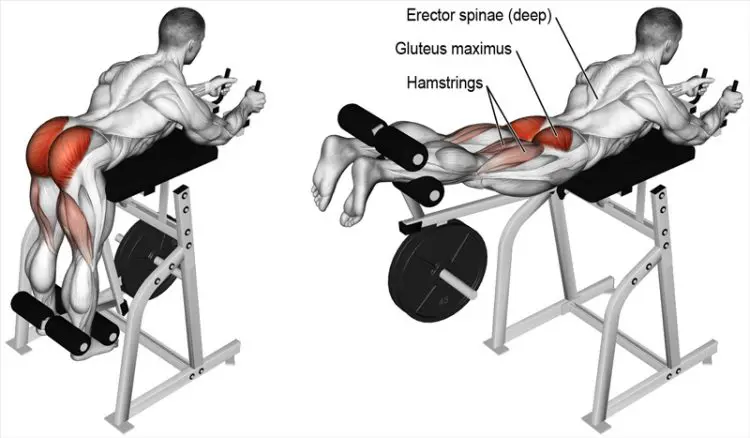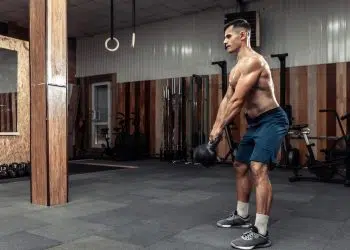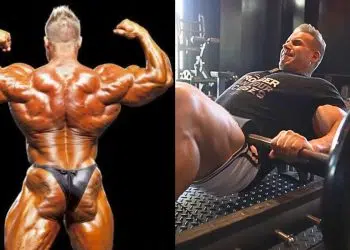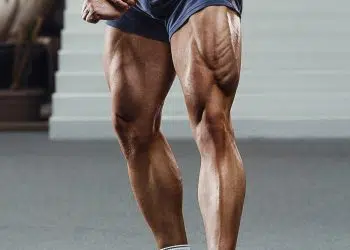In the quest to build a better body, a lot of people go straight for the most intense exercises and workout plans available. While advanced training methods have their place, if you are a beginner, they may be unnecessary.
Take glute training, for example. There are dozens if not hundreds of challenging glute exercises that you can use to tone and strengthen your butt. However, there are also plenty of more straightforward exercises that can be just as effective, especially if you are new to working out.
The donkey kick works the glutes without fancy equipment, so it’s ideal for home exercisers. It’s also easy to learn, making it perfect for beginners. But, with a few modifications, the donkey kick can also provide more advanced exercisers with a great glute workout.
In this article, we reveal why and how to do the donkey kick, plus the ten best progressions, variations, and alternatives.
Donkey Kick – Muscles Worked
Strictly speaking, donkey kicks are an isolation exercise because only one joint moves – the hip. However, despite this, donkey kicks involve several major muscles working together.
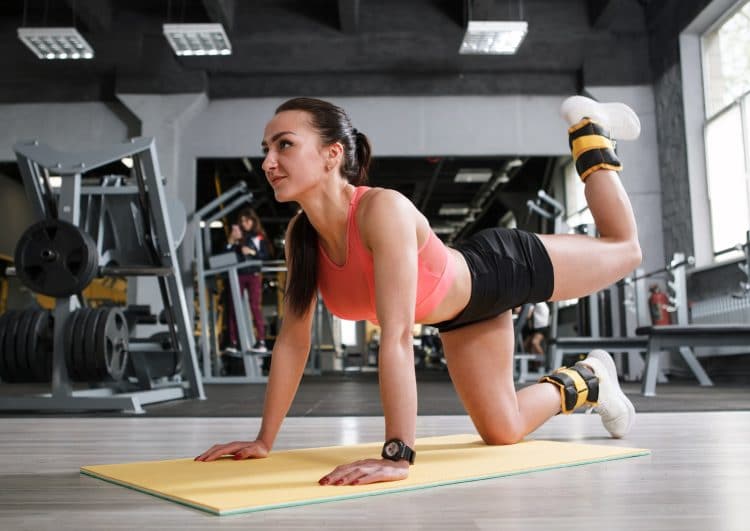
The muscles affected by donkey kicks are:
Level Up Your Fitness: Join our 💪 strong community in Fitness Volt Newsletter. Get daily inspiration, expert-backed workouts, nutrition tips, the latest in strength sports, and the support you need to reach your goals. Subscribe for free!
Gluteus maximus – known as the glutes for short, this is the large muscle located on the rear of your hips. It’s also the largest muscle in the human body. Most people do donkey kicks to strengthen and build the glutes. The Gluteus maximus is your most powerful hip extender muscle.
Hamstrings – working with your glutes, your hamstrings help extend your hip. There are three hamstring muscles; biceps femoris, semimembranosus, and semitendinosus. The hamstrings are also your main knee flexor muscles.
Core – core is the collective term for your midsection muscles, including the rectus abdominis, obliques, transverse abdominis, and erector spinae. Acting a lot like a weightlifting belt, these muscles contract inward to generate intra-abdominal pressure, or IAP for short. IAP stabilizes your lumbar spine and prevents unwanted movement during donkey kicks.
How to Do Donkey Kicks
Get more from donkey kicks while keeping your risk of injury to a minimum by following these guidelines:
- Kneel down on all fours, so your shoulders are directly over your hands, and your hips are over your knees. Your arms should be straight, and hands about shoulder-width apart, fingers pointing forward. Tuck your chin in and lengthen your neck.
- Brace your core and ensure your lumbar spine is neutral, i.e., slightly arched.
- Extending your hip, and keeping your knee bent, lift one leg out and behind you, pushing your heel up toward the ceiling.
- Take care NOT to hyperextend your lower back. Instead, keep your hips/anterior pelvis pointing straight down at the floor.
- Lower your leg back down and repeat on the same side or alternate legs as preferred.
- Make this exercise harder by wearing ankle weights.
Donkey Kick Benefits and Drawbacks
Are donkey kicks the right glute exercise for you? Consider these benefits and then decide!
No equipment required – all you need to do donkey kicks is a little space and something to kneel on, such as an exercise mat or folded towel. With no equipment required, this is the perfect excuse-free glute exercise.
Easy to learn – glute exercises don’t come much more straightforward than donkey kicks. Most people should master this move within a few minutes. As such, it’s ideal for beginners.
Low resistance – while your glutes are the target muscle during donkey kicks, they aren’t under a whole lot of tension. This is NOT a super-intense exercise. So, if you are just starting out on your fitness journey or want a low-stress glute workout, this could be the exercise for you.
Involves the core – to do this exercise correctly, you need to engage your core to stabilize your lumbar spine. Lifting just one leg means you’ll need to brace to keep your hips stationary. Using your core like this is an excellent way to master bracing before attempting more advanced exercises.
While donkey kicks are a mostly beneficial exercise, there are also a couple of drawbacks to consider:
A tendency to hyperextend the spine – some exercisers use an extended range of movement for donkey kicks, raising their foot far too high. Most of this additional movement comes from the spine and not the hip. The extra movement does nothing for the glutes but increases the risk of injury. Don’t do it!
Low resistance – while some people will appreciate the low level of resistance during donkey kicks, it’s a drawback for others. If you’ve got strong glutes, you could need to do 30, 40, or even 50 reps per leg to fatigue your glutes. This makes for an inefficient workout.
10 Donkey Kick Variations and Alternatives
While donkey kicks are an effective glute exercise, that doesn’t mean you need to do them all the time. There are several progressions, variations, and alternatives you can use to keep your workouts productive and interesting:
1. Straight-Leg Donkey Kicks
Doing donkey kicks with your leg straight reduces hamstring activation, so your glutes have to do more of the work. On the downside, it also reduces the range of motion. You can remedy this problem by doing straight-leg donkey kicks while kneeling on a bench so you can move your hip through an uninterrupted range of motion.
How to do it:
- Kneel down on all fours, so your shoulders are directly over your hands, and your hips are over your knees. Your arms should be straight, and hands about shoulder-width apart. Tuck your chin in and lengthen your neck.
- Extend one leg out behind you and rest your toes on the floor.
- Brace your core and ensure your lumbar spine is neutral, i.e., slightly arched.
- Keeping your leg straight, extend your hip, and lift your leg until it’s roughly parallel to the floor.
- Lower your foot to the floor and repeat.
- Swap legs and do the same number of reps on the opposite side.
2. Resistance Band Donkey Kicks
If bodyweight donkey kicks no longer present enough of a challenge, you can do them wearing ankle weights. No ankle weights? Use a resistance band instead. Using a band increases muscle tension as you near the endpoint of each rep.
How to do it:
- Kneel down on all fours, so your shoulders are directly over your hands, and your hips are over your knees. Place a resistance band across the soles of your feet and hold the other end under your hands.
- Brace your core, tuck your chin in, and length your neck.
- Keeping your leg bent, drive your foot back and up toward the ceiling, taking care not to hyperextend your lumbar spine.
- Return to the starting position and repeat.
- Do the same number of legs on both legs.
3. Smith Machine Donkey Kicks
A lot of people are very quick to dismiss the Smith machine as non-functional. However, in reality, the Smith machine is just another training tool that you can choose to use or ignore according to your workout preferences and goals. Doing donkey kicks with a Smith machine is an easy way to overload your glutes. With very little balance required, you’re free to focus on pushing your glutes to failure in relative safety.
Learn how to do this potent glute exercise here.
4. Reverse Hyperextensions
Level Up Your Fitness: Join our 💪 strong community in Fitness Volt Newsletter. Get daily inspiration, expert-backed workouts, nutrition tips, the latest in strength sports, and the support you need to reach your goals. Subscribe for free!
Reverse hyperextensions are basically a two-legged, straight-legged donkey kick. If you want to overload your glutes, this exercise can help. Learn how to do reverse hyperextensions here, including several alternatives if you don’t have access to a reverse hyperextension bench.
5. Hip Thrust
Hip thrusts are a popular glute exercise that can be done using nothing more than your body weight for resistance. They can also be made harder by adding a barbell. For an even more intense workout, try hip thrusts with a booty band around your knees to increase glute activation.
How to do it:
- Lie on your back with your legs bent and feet flat on the floor. Place your arms on the floor by your sides.
- Drive your feet into the floor and push your hips up toward the ceiling. Your knees, hips, and shoulders should form a straight line.
- Lower your butt back down to the floor and repeat.
Make this exercise harder by holding a weight on your hips, using one leg at a time, or placing your feet or shoulders on a step or bench to increase your range of motion.
6. Kettlebell Swings
The swing is a fundamental kettlebell exercise that’s good for almost everybody’s body. Whether you want to power up your posterior chain, build a better butt, or torch fat, the kettlebell swing will help. While kettlebell swings ARE more dynamic and intense than donkey kicks, done correctly, they’re a safe and effective exercise that really hammers your glutes and hamstrings.
Learn how to master the kettlebell swing here.
7. Standing Cable Hip Extensions
This exercise involves using a low cable machine paired with an ankle cuff. It provides an excellent way to progress your glute workouts because you can increase the weight as you get stronger.
How to do it:
- Attach an ankle cuff to your ankle. Fix a low cable to the cuff. Stand facing the cable machine with your arms braced for balance. Bend your non-working leg for extra stability.
- Extend your hip out behind you, keeping your leg slightly bent throughout.
- Return to the starting position and repeat.
- The further away you stand from the pulley, the greater your range of motion, and the more demanding this exercise will be.
8. Single-leg Romanian Deadlift
Single-leg Romanian deadlifts, like donkey kicks, work one leg at a time. However, because they’re done standing, you’ll need to work harder to maintain your balance. This increases glute activation, and also means your hip stabilizers (gluteus minimus and medius, abductors and adductors) are more involved.
Learn how to do this excellent glute exercise here.
9. Cable Pull-Through
Cable pull-throughs are a lower back-friendly exercise produces an intense glute contraction at the top of each rep. You can do them with light weights for high reps, or heavy weights for low reps, making them ideal for all training goals and levels of fitness. They can also be done using a resistance band if no cable machine is available.
How to do it:
- Attach a rope handle to a low pulley machine. Stand with your back to the weight stack, feet astride the handle.
- With your abs braced and shoulders down and back, bend down and grab the handle with both hands. Stand up and take a couple of steps forward to tension the cable.
- Stand with your feet shoulder-width apart, knees slightly bent, hands in front of your hips. This is your starting position.
- Push your hips back and lean forward until you feel a deep stretch in your hamstrings. Keep going until your hands travel behind your knees. Do not allow your back to round. Maintain a neutral spine throughout, and that includes your upper back and neck.
- Drive your hips forward and stand back up, locking your knees and tensing your glutes as you reach the top of your rep.
- Hinge forward again and repeat.
Read more about cable pull-throughs here.
10. Stability Ball Hip Lift and Leg Curl
Like donkey kicks, the stability ball hip lift and leg curl is a great bodyweight glute and hamstring exercise. However, it’s considerably more challenging. That said, because all you need to do it is a stability ball, it’s still a useful move for home exercisers.
How to do it:
- Lie on your back with your legs straight and feet resting on a stability ball. Place your hands on the floor by your side for balance.
- Push your heels into the ball to lift your butt off the floor so your body is straight.
- Next, bend your legs and curl the ball in toward you. Push your hips up to the ceiling as you roll the ball in.
- Push the ball away, so your legs are straight, and then lower your hips back down to the floor.
- That’s one rep – keep going!
Donkey Kicks – Wrapping Up
Donkey kicks are a common feature of group exercise classes. There is a reason they’re so popular; they work! Easy to learn and with no equipment needed, donkey kicks are convenient as well as effective.
They’re the perfect excuse-free way to develop your glutes and hamstrings and are ideal for home workouts.
But, like any exercise, donkey kicks will gradually lose their potency if you do them too often. With limited resistance available, most exercisers soon find that high reps are the only way to make this move sufficiently challenging, and that’s an inefficient use of your training time.
So, master the donkey kick, and then use the variations and alternatives in this article to ensure you continue making progress.
Interested in measuring your progress? Check out our strength standards for Deadlift, Hip Extension, Reverse Hyperextension, and more.

